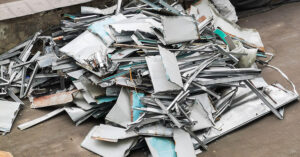In the world of recycling and waste management, balers play a crucial role in compressing materials like cardboard, paper, and plastic into compact, manageable bales. These bales are then easier to transport, store, and recycle.
However, not all balers are created equal, and the choice between a vertical baler and a horizontal baler can significantly impact your operation’s efficiency and cost-effectiveness.
This article aims to shed light on the important differences between vertical balers and horizontal balers, helping you make an informed decision for your business.
Understanding Balers
A baler is a machine used to compress and bind materials into bales, making them easier to handle, transport, and store. The history of balers dates back to the 19th century, with the invention of the hay baler. Over time, balers have evolved to accommodate various materials and meet the demands of different industries.
Vertical Balers
Overview
Vertical balers are characterized by their vertical orientation, where materials are loaded from the top and compressed downwards. They are commonly used in small to medium-sized businesses, such as retail stores, supermarkets, and small manufacturing facilities.
Advantages of Vertical Balers
- Space-saving design: Vertical balers have a smaller footprint, making them ideal for facilities with limited floor space.
- Ease of use: These balers are generally simpler to operate and maintain, requiring less training for staff.
- Cost-effectiveness: With a lower initial investment and operating costs, vertical balers are an affordable option for smaller businesses.
Limitations of Vertical Balers
- Lower capacity: Vertical balers are not suitable for high-volume processing, as they have a slower throughput and smaller bale sizes.
- Manual operation: Most vertical balers require manual loading and unloading, which can be labor-intensive.
Horizontal Balers
Overview
Horizontal balers, on the other hand, have a horizontal orientation, where materials are loaded from the side and compressed horizontally. They are typically used in larger facilities, such as recycling centers, distribution centers, and manufacturing plants.
Advantages of Horizontal Balers
- High capacity: Horizontal balers can handle larger volumes of material, making them suitable for high-throughput operations.
- Automation: Many horizontal balers can be fully automated, reducing the need for manual labor and increasing efficiency.
- Versatility: These balers can process a wide range of materials, from cardboard and paper to plastics and metals.
Limitations of Horizontal Balers
- Space requirements: Horizontal balers require more floor space than vertical balers, which may not be feasible for smaller facilities.
- Investment: The initial investment and maintenance costs for horizontal balers are generally higher than for vertical balers.
Key Differences Between Vertical and Horizontal Balers
When comparing vertical balers vs. horizontal balers, several key differences stand out:
- Orientation and design: Vertical balers compress materials downwards, while horizontal balers compress materials sideways.
- Capacity and throughput: Horizontal balers typically have a higher capacity and throughput than vertical balers.
- Automation and labor: Horizontal balers often offer more automation options, reducing the need for manual labor.
- Space and footprint: Vertical balers have a smaller footprint, making them more suitable for limited spaces.
- Cost: Vertical balers are generally more cost-effective, with lower initial and operating costs.
Choosing the Right Baler for Your Business
Selecting the right baler for your business involves assessing your specific needs and considering various factors:
- Volume of materials: If you have a high volume of materials to process, a horizontal baler may be more suitable. For smaller volumes, a vertical baler may suffice.
- Types of materials: Consider the types of materials you need to bale and whether a vertical or horizontal baler is better equipped to handle them.
- Available space: Ensure you have enough space in your facility to accommodate the baler you choose.
- Budget: Balance the initial investment against the long-term savings in labor, transportation, and storage costs.
- Future growth: Consider whether the baler you choose can scale with your business as it grows.
Conclusion
In the debate of vertical balers vs. horizontal balers, there is no one-size-fits-all solution. The right choice depends on your business’s specific needs, including the volume and types of materials you need to process, the available space in your facility, and your budget.
By understanding the important differences between vertical and horizontal balers, you can make an informed decision that optimizes your recycling and waste management processes.
Contact Nanoia Recycling Equipment for Custom Solutions
At Nanoia Recycling Equipment, we understand the critical role balers play in your recycling and waste management efforts. Whether you’re looking for a vertical baler
for your small retail store or a high-capacity horizontal baler for your large recycling center, we have the expertise and equipment to meet your needs.Contact us today for a custom solution tailored to your business’s unique requirements.






